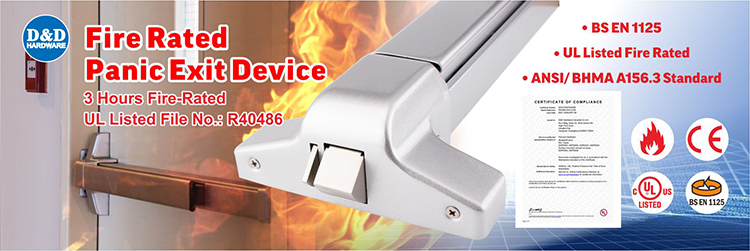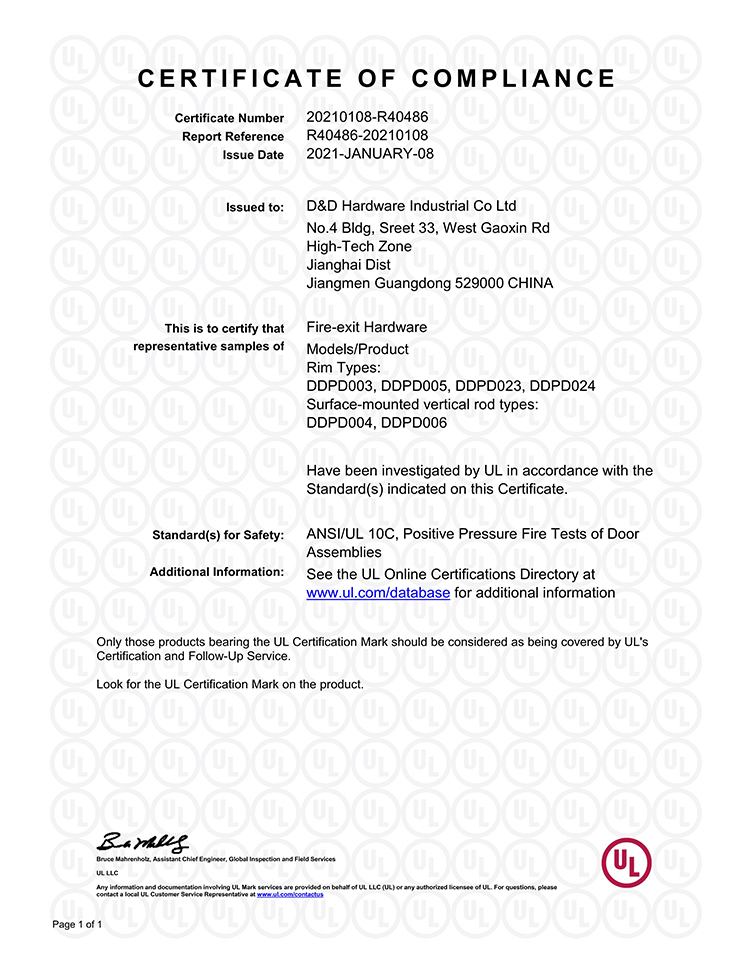Views: 0 Author: D&D Hardware Publish Time: 2020-12-08 Origin: D&D Hardware

An exit device is a piece of hardware mounted on the push side of a door. It is designed to release a latching mechanism in the event of panic. Exit devices are intended to operate without prior knowledge or training when pressure is applied to horizontal bar or push pad mounted to the door.
Because of their direct effect upon life safety, exit devices are one of the most important hardware items in a building.
Panic Hardware and Fire Exit Hardware are two different types of exit devices, and the proper selection is determined by code requirements.
Panic Hardware:
Panic Hardware is an exit device which is tested for use on a door that is required to have panic hardware, but cannot be used on a fire door. Panic hardware typically has the dogging feature, which allows the latches to be held retracted to create a push/pull function.
Fire Exit Hardware:
Fire Exit Hardware is an exit device which is tested for both panic and fire conditions and is required to be used on fire doors where panic hardware is required by code or desired for durability.
Fire Exit Hardware shall be listed in accordance with UL 10C and UL 305;
Fire Exit Hardware intended to keep a fire door latched to prevent the spread of smoke and fire, thus maintaining the integrity of the fire assembly.
Since fire doors require positive-latching, fire exit hardware does not incorporate mechanical dogging. If a push/pull function is desired for a fire door, electric latch retraction hardware may be installed, as long as the latch projects automatically upon fire alarm.
The International Building Code (IBC) and NFPA 101 – The Life Safety Code contain similar requirements for locations where panic hardware is installed:
1.Panic hardware shall be listed in accordance with UL 305;

2.Fire Exit Hardware shall be listed in accordance with UL 10C and UL 305;
3.The actuating portion of the releasing device shall extend at least one-half of the door leaf width;
4.The maximum unlatching force shall not exceed 15 pounds (67 N).
5.If balanced doors are used and panic hardware is required, the panic hardware shall be the push-pad type and the pad shall not extend more than one-half the width of the door measured from the latch side.
Tests & Label:
To be listed as acceptable for these uses, a sample device must pass a series of tests. The two most important are that the device operates for a specific number of cycles, and that the opening pressure(force required to release the device) must not exceed certain levels. Both Panic hardware and Fire Exit hardware must pass this portion of the test. The maximum force to unlatch the device is specified in most model building codes.
Before a device can listed as Fire Exit hardware it must pass further testing. Complete assemblies of doors, frames and hardware are put together in a wall to form an assembly on which a laboratory fire test will be performed. Depending on the length of the fire test, the devices will be listed as 3 hour(A Label); 1 ⅟2hour(B Label) or possibly a shorter time.
Note: Doors which are constructed to accept fire exit hardware will bear a label noting this fact. The label of the device also will indicate it is a Fire Exit Hardware device.
Construction:
While Panic hardware and fire exit hardware can appear to be aesthetically the same, there are significant internal differences in their construction.
The latching assemblies on fire exit hardware have to be constructed in such a manner as to ensure the doors will be held in the closed and latched position during a fire.
Dogging:
Another difference between panic hardware and fire exit hardware is that panic hardware is permitted to have a feature called dogging. The dogging feature holds the latchbolt(s)in the retracted position so that the doors may be used as push/pull. Dogging is accomplished either by a hex key or cylinder installed on the body of touch bar devices, or by a hex key in the hinge and lock cases of crossbar devices.
Dogging is prohibited on fire-rated devices because it prevents the latch-bolt from keeping the door in the latched position.
How do we know when we shall use fire exit hardware?
The requirement for using “exit device” or fire exit hardware usually is based on the occupancy classification of the building or area and the occupant load (quantity of persons using the facility).
The National Fire Protection Association(NFPA) publishes the Life Safety Code, which designates when exit devices are required to be used in a building or space.
• Exit devices are required to be used on openings serving an occupant load of 100 people or more, and high hazard areas with occupant loads of 5 or more.
• NFPA 101 requires fire exit hardware to be installed on fire-rated openings in a means of egress.
D&D has both Fire Rated Exit Hardware and Panic Hardware .
Our Fire Rated Exit Hardware has tested to UL 10C fire rated standard, suitable for both timber and metal doors.
Available in both Rim type and Vertical rob type.
Available in SUS 304 grade & Painted steel.
Available in different finishes.
Should you have any further questions or inquiries, please feel free to contact us.

For further information about Panic Exit Device or any of our services, click here.
Contact: David Jian
Mob: 0086-139 2903 7292
Email: David@dndhardware.com, sales@dndhardware.com
Jobby Zhang
Mob: 0086-137 2599 9617
Email: jobby@dndhardware.com